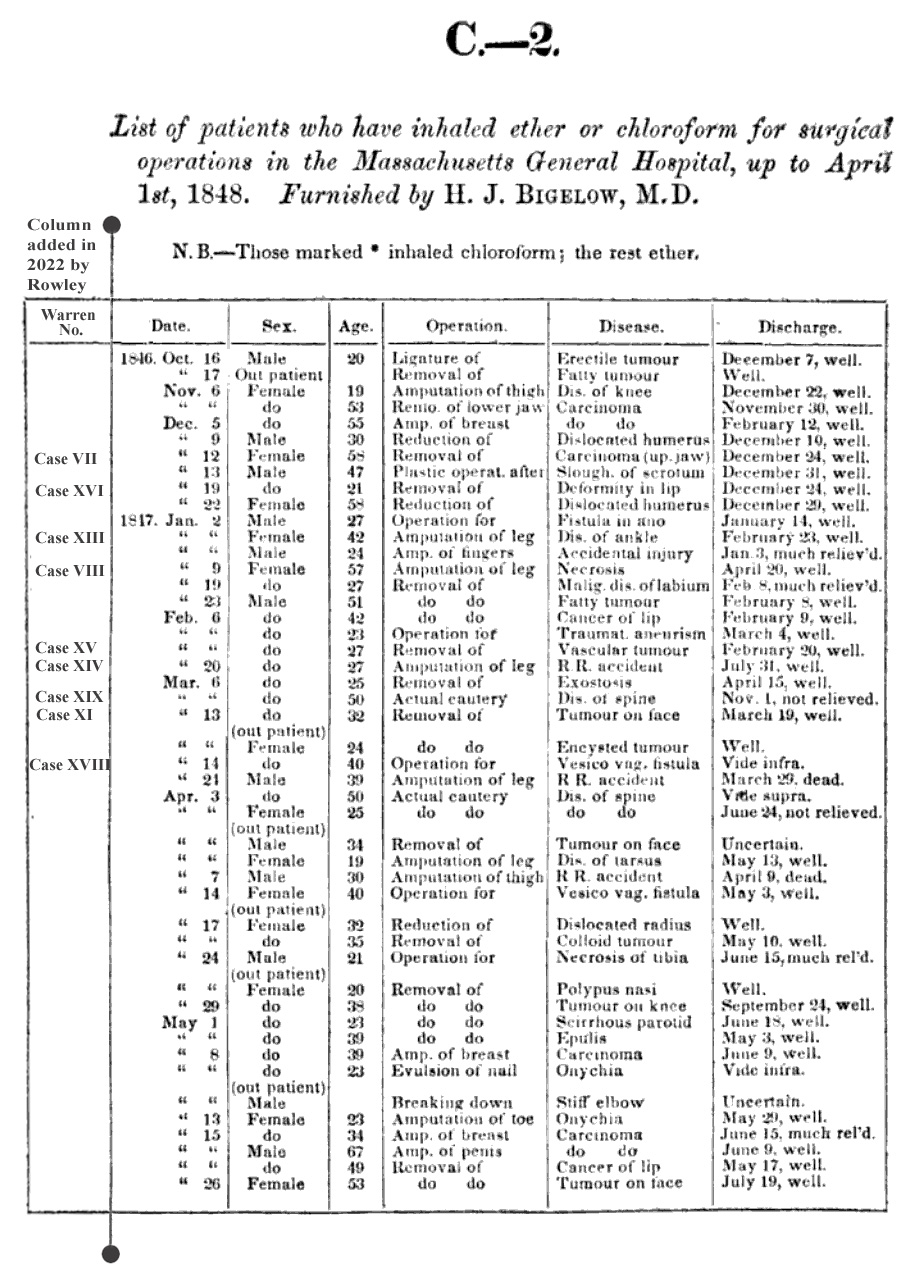

No documentation exists to support the Lowry & Lowry conjecture that the "reenactment" daguerreotype was "probably taken in December 1846," except maybe a pressing need to commemorate the event, if I understand their context correctly.(66) Likewise, Wolfe gave no documentation to back up the caption he wrote for the daguerreotype reproduced in his monograph on Morton, describing it as a "Reenactment, probably late March or Early April 1847, of the first operation under ether."(67) He also placed the enactments of the other Ether Dome daguerreotypes in the month of April, even though Bigelow's hair is considerably longer in the photographs. The expediency of photographing multiple daguerreotypes on the same day is a reasonable assumption, discussed under the scenarios for EDD Nos. 2-5, but doesn't hold for the "reenactment" daguerreotype, No. 1.
Abbott convalesced nearly seven weeks at MGH until his discharge date on December 7. He was available to pose for a reenactment of his surgery anytime, but I doubt a commemorative photograph was uppermost on the minds of the MGH surgical staff as they struggled to manage the global disruptions of an astounding surgical innovation, said to be a miracle boon for humanity. It would have been premature to proclaim victory in the vanquishing of pain with a photo op so soon after the Abbott and Alice Mohan surgeries. Ether anethesia remained raw and experimental while Bigelow, Hayward, and the Warrens, worked out the clinical and physiological effects in their case notes. The more egregious hazards of choking, irritation, and asphyxiation weren't resolved until the following February or early March when Morton's device was replaced by the conical sponge. Charles Jackson was aggressively pushing his priority claims against Morton. These circumstances were not conducive for taking a commemorative or promotional photograph, but they also argue against the scenario of photographing an actual surgery, may be even more inhibitive, considering the added risk of introducing a foreign element – a photographer and his camera – into the amphitheater during a procedure. Not until anesthesia was better understood, controls were in place, and the surgeons were absolutely certain a postmortem wouldn't be taken, would they want a photographer there to record the event. Unless, that is, an opportunity arose for photographing a minor operation under ether with no spectators in the bleachers, such as the reduction of a dislocated shoulder, a scenario which will be discussed under Parkman's paper below.
It should be noted, too, that a photo session for an active surgery would require either clearing out the bleachers of spectators, or scheduling when public attendance was de minimus. From Townsend's testimony in the Morton patent trial, referenced above, attendance averaged around 100 during the Harvard Medical College lecture season, beginning in the first week of November and ending the first week of March, and averaged between 25 to 50 off-season. The Abbott operation was off-season, but the Alice Mohan surgery took place on November 7 (date of record) and attracted a crowd of over 300 curious spectators, drawn by the significance of the occasion.
The published resource of the classical ether operations at MGH is found in Bigelow's second treatise published in 1848, a much more comprehensive paper with information on the advances achieved in understanding the clinical management of administering an anesthetic.(68 »») Bigelow's paper was supplemented by a table compiled by Dalton of all the ether operations conducted at Massachusetts General Hospital, dating from the Abbott operation to December 4, 1847, enumerating 154 operations by columns for patient age, gender, operation, disease, and admittance & discharge dates. Cross-checking Bigelow's tables with a search of the literature turns up the dates of several surgeries that comport with the apparent age of the patient in the "reenactment" daguerreotype:
|
The two leg amputations (nos. 4 & 6) can be eliminated as the severe trauma isn't indicated by the subject in the daguerreotype. Similarly, Dr. Hayward's repair of fistula in ano (no. 2) doesn't accord with the clinical picture. There are no published accounts on an April 3rd operation (no. 7) for the facial tumor of a 34-yr-old male subject, but it warrants further investigation and will be covered under that segment below. Altogether, there are four surgeries that are promising candidates for EDD No. 1, provided the daguerreotype depicts an actual surgery: numbers 1, 3, 5, and 7. They will be addressed in turn under the following segments.
66.) Lowry & Lowry (2005); p. 78. "The completed daguerreotype (fig. 1), probably taken in December 1846, allows us to judge the effectiveness of their [Southworth & Hawes] preparations."
67.) Wolfe, RJ (2001); Figure 12, p. 78. A more detailed description appears on page xi: "Figure 12. Reenactment, probably also occurring in April 1847 and daguerreotyped by J. J. Hawes, of the first operation under ether. Those who can be identified are Solomon D. Townsend (second from the front on the left), Samuel Cabot (beside the person holding the ether inhaler), and J. Mason Warren (second from the front on the right). Reproduced from a print originally in the possession of the Morton family and now in the Harvard Medical Library."
68.) Bigelow, HJ (1848); Table C.-2. on pages 215-217. The MGH table was prepared by John Call Dalton, vide: footnote, p. 10 of the annual report for Massachusetts General Hospital (January 26, 1848), where it is stated, "Dr. Ralph K. Jones, one of the house physicians, politely copied for the use of the Committee a list of all these 132 cases (prepared by Dr. Dalton, one of the house surgeons, for a different purpose)."
